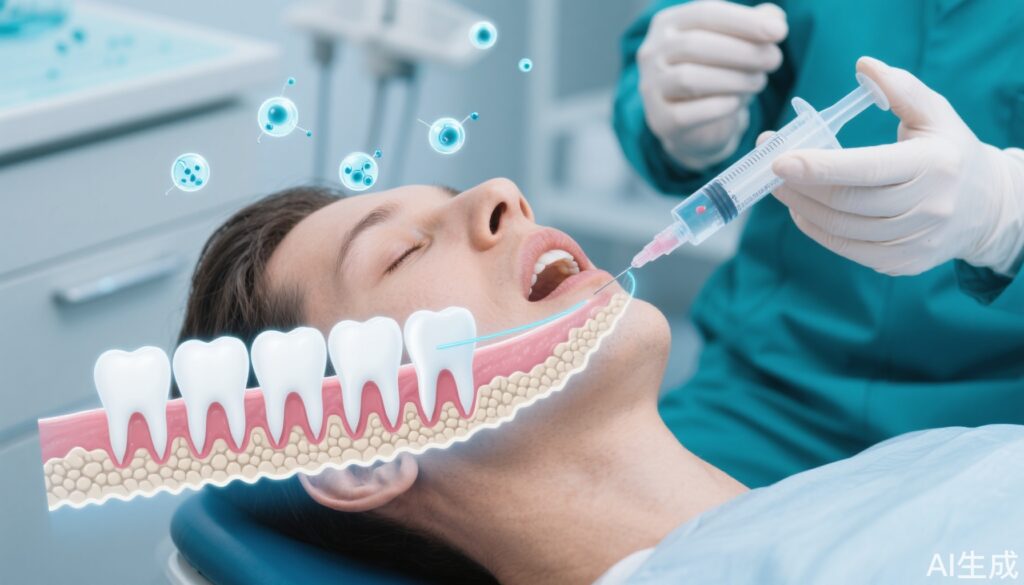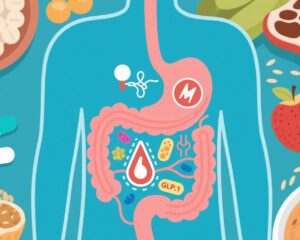Highlight
– A multicenter randomized clinical trial demonstrated that injectable allogeneic dental pulp stem cells (DPSC) can significantly promote alveolar bone regeneration in chronic periodontitis without surgery.
– The treatment showed superior outcomes compared to placebo (saline) injection, with statistically significant improvements in bone defect depth and periodontal attachment levels.
– The procedure is minimally invasive, safe, and well-tolerated with only mild, transient adverse effects.
– This heralds a potential paradigm shift in periodontal therapy, emphasizing regenerative medicine over traditional surgical approaches.
Study Background and Disease Burden
Periodontitis is a chronic inflammatory condition characterized by progressive destruction of the supporting structures of the teeth, including the alveolar bone, periodontal ligament, and gingiva. Globally, more than 700 million individuals suffer from this condition, making it the leading cause of adult tooth loss. Beyond local effects, periodontitis has been linked to systemic conditions such as diabetes mellitus, cardiovascular disease, and certain cancers, underscoring its public health significance.
Traditional treatment for severe periodontitis often involves surgical interventions like bone grafting and guided tissue regeneration to restore the lost alveolar bone. Although effective, these procedures carry disadvantages including invasiveness, longer recovery times, patient discomfort, and variable regenerative outcomes, limiting their widespread acceptance.
Recent advances in stem cell biology have offered promising alternatives. Dental pulp stem cells (DPSC), derived from the dental pulp of extracted healthy teeth, have osteogenic potential and immunomodulatory properties, making them ideal candidates for regenerative therapy. Prior experimental studies and animal models suggested DPSC can foster periodontal tissue regeneration, but robust clinical human data were lacking—until now.
Study Design
This randomized, double-blind, placebo-controlled multicenter study, conducted by Beijing Stomatological Hospital and Peking University Third Hospital, enrolled 132 patients with chronic periodontitis involving 158 affected teeth. Participants were randomly allocated to receive one of several doses of allogeneic DPSC injections or a saline placebo.
DPSCs were obtained from healthy donors, rigorously screened, cultured, and quality-controlled to ensure differentiation potential into bone and other lineages while minimizing immunogenicity. Under local anesthesia, approximately 10 million viable DPSCs suspended in a liquid medium were directly injected into the periodontal pockets, avoiding incisions or implantation of bone substitutes.
Primary endpoints assessed at six months included:
– Alveolar bone defect depth (BDD)
– Clinical attachment level (AL)
– Probing depth (PD)
– Gingival recession (GR)
– Tooth mobility (TM)
Safety and adverse events were closely monitored throughout.
Key Findings
Compared with the control saline group, the DPSC-treated patients demonstrated significantly greater alveolar bone regeneration. The mean improvement in bone defect depth was 0.30 mm versus 0.04 mm in controls, a difference both clinically meaningful and statistically significant (p <0.05). Notably, such bone regeneration is extraordinarily rare in nonsurgical periodontitis treatment.
Patients with severe (stage III) periodontitis, characterized by attachment loss ≥ 5 mm, exhibited even more pronounced responses. In this subgroup, clinical attachment level improved by an average of 1.67 mm (26.8% improvement) compared to 1.03 mm (17.4%) in controls, underscoring the efficacy of DPSC therapy in advanced disease.
Beyond soft tissue parameters, the regeneration of the alveolar bone—critical to long-term tooth stability—represents a major advance. This suggests that DPSC facilitate not only repair of the gingiva and ligament but also true restoration of the hard tissue matrix, creating a "from inside out" healing process.
Safety analysis was reassuring. Among all 132 patients, no serious adverse events were reported. Mild injection site swelling and transient toothache occurred in a small fraction and resolved spontaneously without intervention. These findings support the good tolerability and clinical feasibility of allogeneic DPSC treatment.
Expert Commentary
This landmark clinical trial represents over a decade of scientific groundwork in China, where researchers have successfully developed the first dental pulp stem cell-based therapeutic for periodontitis, approved to advance to clinical trials.
Mechanistically, DPSC contribute to regeneration not only via their ability to differentiate into osteoblasts but also by modulating the local microenvironment. They secrete various growth factors and cytokines that regulate immune responses and activate endogenous repair pathways, providing a synergistic healing effect.
While these results are promising, certain limitations remain: the sample size needs expansion, and long-term efficacy beyond six months requires further investigation. Moreover, real-world application awaits larger scale studies and regulatory approvals.
Nevertheless, this approach could revolutionize periodontal therapy by shifting the paradigm from invasive surgical repair towards minimally invasive regenerative medicine. Potentially, one simple injection might one day replace complex surgeries for millions suffering from periodontitis.
Conclusion
The clinical trial of injectable allogeneic dental pulp stem cells offers an innovative, effective, and safe treatment modality for regenerating alveolar bone in periodontitis patients. This non-invasive therapy heralds a new era in periodontal disease management by harnessing the body’s regenerative potential without the trauma of surgery.
Beyond dentistry, the therapeutic principles established by this study provide valuable insights for regenerative treatment of other tissue defects such as osteoarthritis and chronic skin wounds. The future of regenerative medicine shines brighter as a single injection now holds the promise of restoring damaged bone and soft tissue.
References
Liu, Y., Liu, Y., Hu, J. et al. Impact of allogeneic dental pulp stem cell injection on tissue regeneration in periodontitis: a multicenter randomized clinical trial. Signal Transduction and Targeted Therapy 10, 239 (2025). https://doi.org/10.1038/s41392-025-02320-w
Additional references for context:
– Chapple IL, Van der Weijden F, Doerfer C, et al. Primary prevention of periodontitis: managing gingivitis. J Clin Periodontol. 2015;42 Suppl 16:S71-6.
– Graziani F, Gennai S, Solini A, Tonelli M. A systematic review and meta-analysis of the effect of adjunctive systemic and local antimicrobials in nonsurgical treatment of periodontitis. J Clin Periodontol. 2018;45(5):525-546.
– d’Aquino R, Papaccio G, Laino G, et al. Human dental pulp stem cells: from biology to clinical applications. J Exp Zool B Mol Dev Evol. 2011;316(5):408-15.



